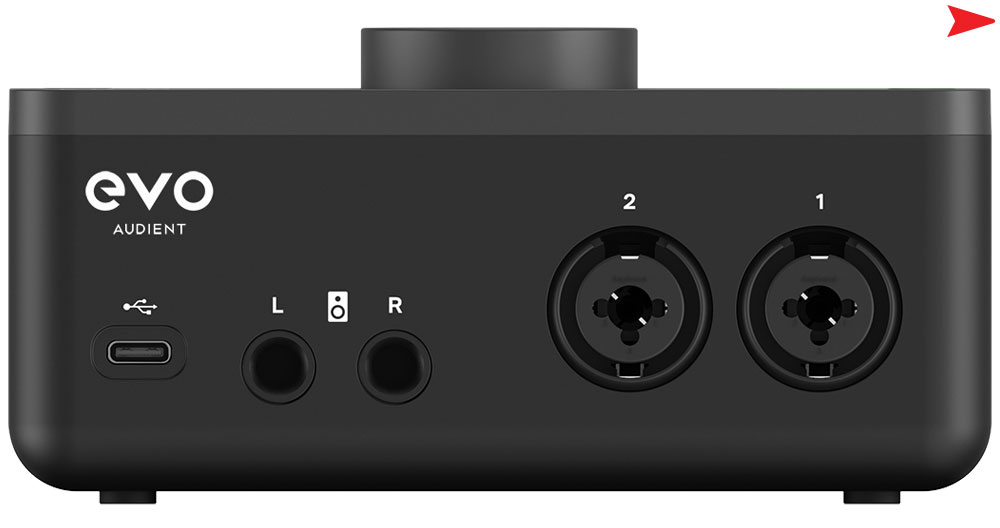Audient recently debuted their EVO series of computer audio interfaces, EVO 4, EVO 8 and EVO 16, which are designed to be extremely simple to use, while retaining a high-standard of sound quality. We tested the EVO 4 to evaluate how a $129 two-channel computer audio interface faired in real world use.
The small brick measures 40mm Wide x 67mm Height x 67mm Depth and has a large volume knob, a 48v button for phantom power, two channel buttons, a gain level button, a montors/headphone volume out button and Audient’s green smart gain button on top. The front features a 1/4″ guitar input and a 1/4″ Headphone output. The back has USB-C connectivity, 1/4″ L/R Monitor outputs and two XLR combo jacks. The unit is bus powered, negating the need for a power supply.


For a limited time only! Up to 80% off all Waves Bundles. PLUS click the banner above or the Go button for an additional 10%! This is Waves best deal yet! Get yours today before this special ends! Go!
Constructed of plastic, the build quality is above average, but obviously some corners were cut to funnel the resources to the internal components. It’s not junk, like some of the IK Multimedia entry-level products we recently reviewed, but the reveals we had in our test unit could have been tighter. Obviously some considerations had to be made to meet the price point, but this is Audient, and we have high expectations. The EVO’s are conceptualized in the United Kingdom, but made in China, which could also be the culprit.
A Brick With Big Features
Weighing in at 360g, the EVO 4 is easy to transport and throw into a backpack. And this is where we found the EVO 4 shines. If you’re one who likes to compose music “in the wild,” whether it be on your laptop at Starbucks, on your daily commute or on a mountain top, the EVO 4 could be your trusty companion. It packs plenty of flexible connectivity that can handle most recording chores into its small frame and punches above its weight in sound quality with 24bit / 96kHz resolution and low noise.
Audient describes its A/D conversion as “class leading” but doesn’t get specific on exactly what’s under the hood, handling that action. We found both the JFET Instrument Input and the XLR combo jacks to provide plenty of headroom and can handle a maximum input of about +9.3dBu of gain for those electric guitarists out there. The phantom power provides the juice that condenser mics require, but can drain a laptop’s battery with extended use. We used RODE’s new 5th generation NT1 and achieved nice results when recording Classical Guitar about 6 inches way from the sound hole with detailed highs and a robust low-end.

We also tested the EVO 4 in a mobile podcast rig and found it was an elegant solution for novices who are looking to do remote interviews. We cite novices here simply because of the EVO 4’s Jedi Power, their new Smartgain feature, allows users to dial in the optimal recording level utilizing Audient’s proprietary algorithm. Smartgain employs peak analysis to automatically evaluate, adjust and set gain levels. Users simply send in a signal from any input and hold down the magic green button on the top. The EVO takes about 15 seconds to analyze the signal and set the gain for you. The only caveat is that the algorithm takes an average of the incoming signal and can’t adjust for sudden peaks, such as laughter, when recording.
Singer / songwriters who compose with a keyboard or a guitar may find the EVO 4 to be a trusty companion to capture songs the moment inspiration strikes. It’s breeze to setup and can be used with something simple like Garageband or equivalent to quickly record your creative spark.

Singer / songwriters who compose with a keyboard or a guitar may find the EVO 4 to be a trusty companion to capture songs the moment inspiration strikes.
Audient EVO 4 Features:
- Two EVO Microphone Preamps
- 24bit / 96kHz
- Smartgain
- JFET Instrument Input
- USB 2.0
- Monitor Outputs
- Headphone Output
- Compatible with Mac, Windows and iOS
- Monitor Mix
- Monitor Pan
- Audio Loop-back
- Bus Powered
- Phantom Power
- Microphone Preamplifier Gain Range: 58dB
- Phantom Power: 48v +/-4v @ 10mA/Channel
- SNR: 100dB
- Frequency Response: 10Hz to 40kHz

The easiest way for electronic musicians to get their music onto Spotify, Apple Music, iTunes, Amazon Music, Tidal, Instagram, Facebook, TikTok, Pandora, Twitch & much more! Click the banner above or the Go Button to save 7% off of your signup! Go!
Conclusion
As an entry-level computer audio interface, the EVO 4 packs a lot of features and quality into its diminutive size. One of our reviewers felt it sounded much more present and detailed than the Focusrite Scarlett and doesn’t come with that unit’s meme stigma. Audient did cut some corners with the EVO 4’s chassis, which they should consider upgrading for the next version (see The Future below —Ed.), but that’s just one small negative for an interface at this easy price point. Recommended.
Audient EVO 4 Rating: 91%
Cheers:
+ Value
+ Sound Quality
+ Smartgain
+ Easy To Use
+ JFET Instrument Input
+ Monitor Output
Jeers:
-Can’t Use Headphone Out and Master Out At The Same Time
– Chassis
– “Brick” Aesthetic
– USB 2.0
– No MIDI

Audient’s EVO 4 costs $129 and is available now.
The Future: While the EVO 4 is a solid offering from Audient, we feel that the unit’s chassis should be addressed, considering the brand’s pedigree. The Brick-like format is a bit clunky and one of our evaluators didn’t care for the aesthetic. Another suggested recessing the “one-knob” button on top so there would be nothing that could potentially compromise the EVO when transporting the unit. Something that definitely needs to be corrected is the inability to use the Headphone Output and the Master Output at the same time, since they cancel each other out. Finally, the addition of MIDI would complete the EVO’s all-in-one value proposition and open it up to another market segment.






